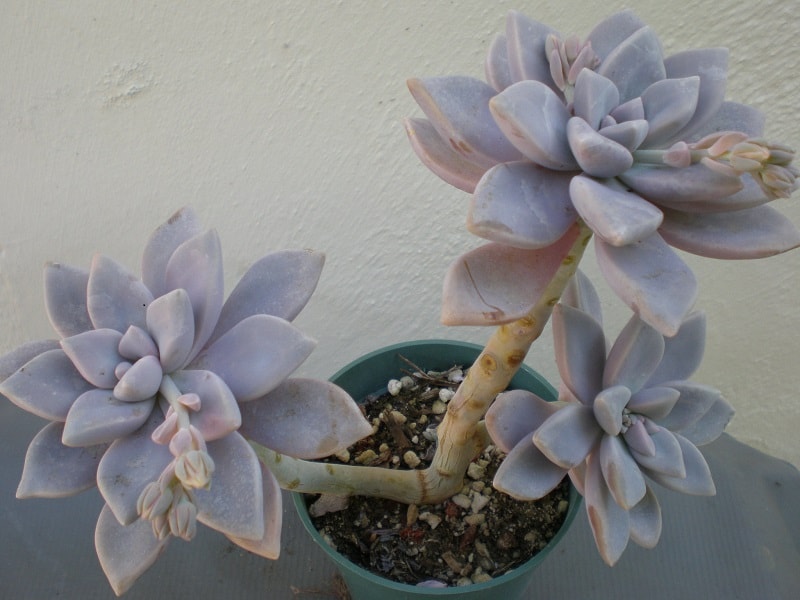In this publication, we will refer to a succulent plant much admired in the gardens.
Mother of Pearl is a plant of the Crassulaceae family and belongs to the genus Graptopetalum.
The genus has about 18 species accepted so far and its scientific name refers to the spots observed in the petals of its flowers.
Graptopetalum Paraguayense “Ghost Plant” is one of the best known and cultivated species because besides being beautiful, it does not need much care for its proliferation.
The Mother of Pearl plant is originally from Mexico and, for its ornamental use, has been commercialized and cultivated in many countries of the world (mainly in tropical regions).
The leaves in this species as well as many crass are arranged in rosettes.
The leaves tend to be elongated and have an intermediate color between green and gray.
Pink regions often appear on the tips of the leaves (some varieties do not have these spots or are not very evident).
The leaves are covered by a protective layer that prevents direct sunburn.
This species has an intermediate stem growth and the leaves are only arranged at the end of it.
They can reach up to 20 cm high depending on the level of lighting of the habitat where it grows.
The flowers are small, white with a light red center and have a starry shape.
These arise in the upper region of the plant with the formation of a floral “stem”.
These are arranged in lateral inflorescences called panicles (floral stem that is divided into several flower clusters and that this decreases in size towards the apex).
The flowering season occurs mainly from February-May.
You may like Gymnocalycium Mihanovichii
Tips to take care of the Graptopetalum Paraguayense “Ghost Plant”
Mother of Pearl is one of the toughest succulent plants I know and the one I would most recommend to anyone who wishes to have a succulent and has little time to attend it.
I planted this species once in a region of my garden (one plant) and in a matter of months, it had proliferated enormously (I found more than 20 daughter plants) and only with natural irrigation.
But although this plant proliferated very well, I found many with some defects or dead.
Therefore, to grow this plant 100% (if you have time for care) I leave these tips:
Temperature
It should grow in warm areas where the temperature remains constant throughout the year (it grows best in tropical areas).
Ideal temperatures should range between 20-28 ° C.
Avoid exposing it to temperatures below 10 ° C and much less to frost.
Low temperatures will kill her.
Lighting
Place our plant in a very bright place.
You can be in full sun without problems but a few hours of shade a day would be optimal.
This species has a protective layer on its leaves to prevent sunburn.
Watering
Water the plant in warm seasons (summer) when the substrate is completely dry. In winter, stop watering (it can be watered once a month) and water very little during the flowering season.
Watch out! Avoid wetting the leaves because they will lose their protective layer, and with this, they can burn by the sun.
Fertilize
Pay the plant in July or August only once a year with liquid fertilizers for succulent plants.
Substrate
The substrate must have very good drainage to prevent root rot.
I recommend mixing the soil with small stones and sand.
This mixture greatly improves water drainage.
Pests and diseases
The main pests that attack this plant are cochineals and coccids (in extreme cases they dry the plant completely).
The pathologies I know are the following: If the leaves begin to feel more fragile and wrinkled, it is a symptom of lack of irrigation and if they appear on them and the stems, brown or black spots, is a symptom of excess water.
Propagation
The Graptopetalum Paraguayense “Ghost Plant” like any flowering plant, it can be reproduced by seeds but it is a very complicated method.
This species, like many crass, has asexual reproduction from its leaves and stems.
To reproduce it quickly, we just have to take a leaf and place it on the substrate; from it, a new plant will emerge.
You can also take stem fragments with leaves for reproduction.
